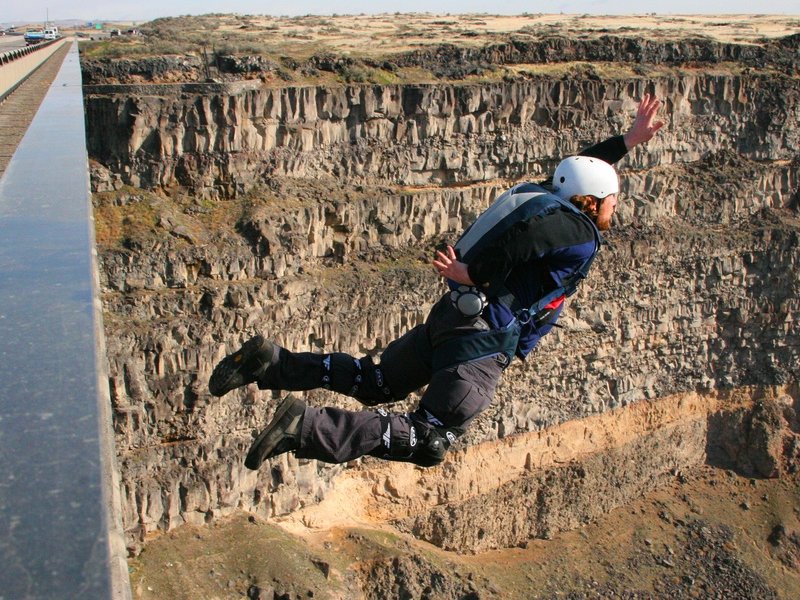What equipment do you need for base jumping? Being an extreme twist on regular skydiving, you may think base jumpers use the same equipment skydivers do. But that’s certainly not the case. With the typical low altitudes and proximity to dangerous objects, base jumping relies on specific equipment.
While some base jumping equipment will be similar to skydiving gear, understanding base jumping equipment requires a lot of additional education and experience. And while base jumping equipment can be rented, if you want to become a serious and regular base jumper, you’ll want to build your own base jumping rig.
Let’s take a look at how base jumping equipment differs from skydiving equipment. We will also look at a typical base jumping rig and what each piece of equipment is for.
Does base jumping use skydiving equipment?
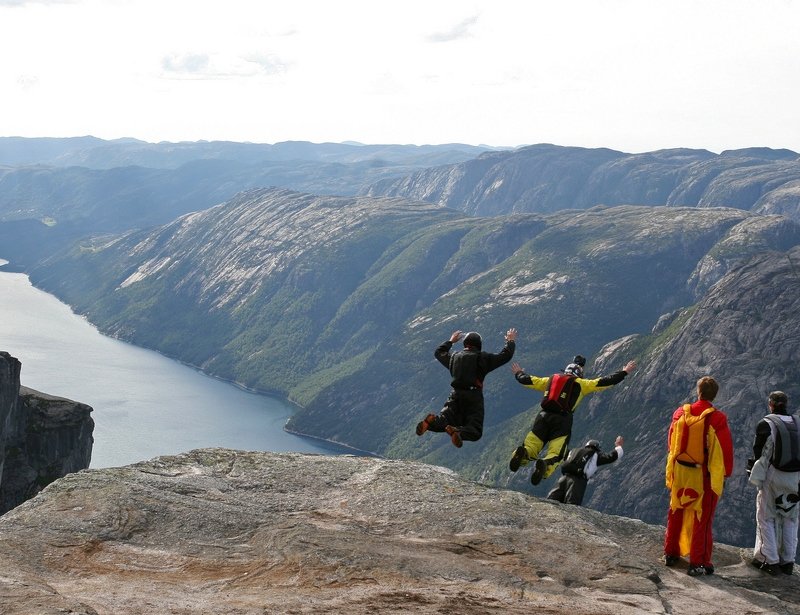
During the late 1970s and early 1980s, pioneering base jumpers would use heavily modified skydiving equipment. There was no base jumping specific equipment available at that time, so it was essential to remove pieces of skydiving gear such as the deployment bag and slider to maximize the speed a parachute could be deployed. Early base jumpers would also build much larger pilot chutes to help inflate the main (and only) parachute quicker. With all these modifications came a much greater risk of broken lines, line-overs, and other potentially fatal errors. Fortunately, the sport has progressed a great deal, and now specifically designed base jumping equipment is much more reliable and safer.
A modern base jumping rig setup uses a one-parachute system (there is no time to cut away a defective main chute or deploy a reserve). With base jumping, less really is more, and simplicity is the safest design. The best base jumping parachutes are the ones that open quickly and reliably.
Skydiving equipment contrasts this with far more detail and complexity. A skydiving rig is built around safety and comfort, knowing that there is plenty of time for corrections and backups should anything go wrong (however unlikely that is). As well as having the main chute, a skydiver will also have a reliable reserve and an automatic activation device that steps in and deploys the parachute should the skydiver fail to do so.
One notable difference between skydiving and base jumping equipment is approval. Skydiving equipment is rigorously tested and must pass the strict standards of the Federal Aviation Administration (FAA). In contrast to this, there is no governing body that approves or monitors base jumping equipment.
What equipment do base jumpers use?
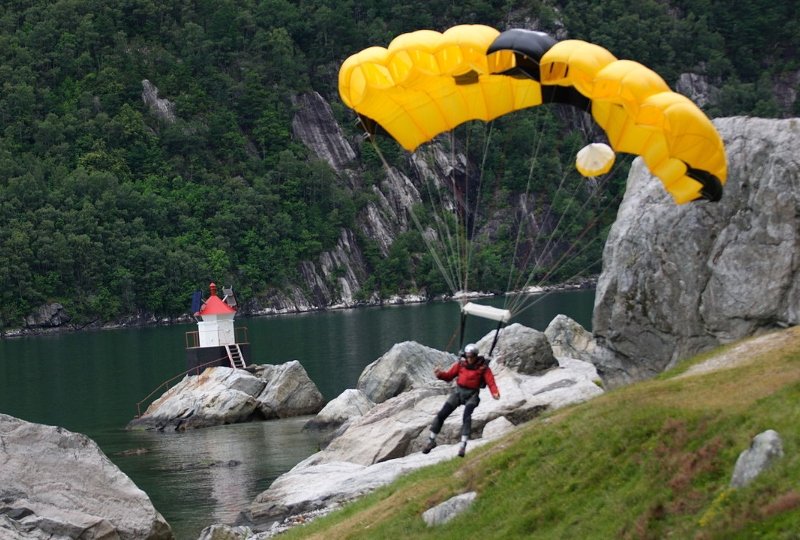
While base jumping equipment focuses on simplicity and reliability, there is still a lot of necessary equipment you’ll need. From a fast and effective parachute rig to ensure a soft landing to protective body armor to step in when that landing isn’t so smooth. Let’s run through the key pieces of base jumping equipment:
The Canopy
Since base jumping specific equipment has evolved, there are now a few different base jumping parachutes to choose from. The most popular and widely regarded as the safest parachute is a vented canopy. These vented canopies have small openings (vents) on the front face, creating much quicker inflation and help to maintain that inflation when jumping at low altitudes and falling at lower speeds. When purchasing a canopy for base jumping, it’s essential to consider your body weight and other gear and clothing you’ll be wearing to get the correct wing load.
Container
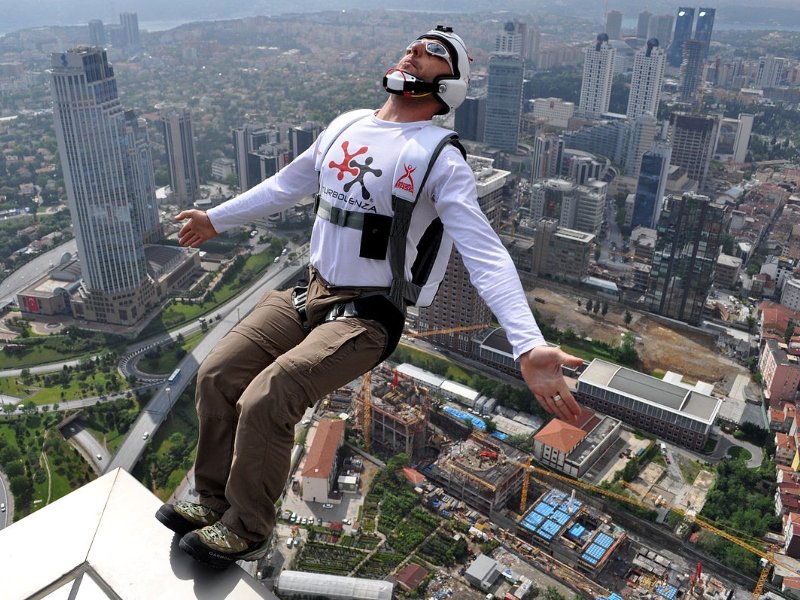
A base jumping container is much simpler, smaller, and lighter than a skydiving container. There are three main types of base jumping containers; single-pin, dual-pin, and velcro-closed containers. A single-pin container uses a curved pin looped near the center and fixed with the bridle. The dual-pin has one pin at the base of the container and a second at the top. The velcro-closed container is popular with wingsuiters, which is now growing in popularity with base jumpers.
Bridles
Bridles connect the canopy and pilot chute. The bridle is a relatively cheap and straightforward piece of gear but very important. There are a few different material options, but the best to opt for is square weave nylon or 720-pound dacron line. Due to the lower airspeed of base jumping, the bridles need to be longer than skydiving bridles and are usually around 9 feet long. For additional safety and reliability, many base jumpers will use a multi-bridle attachment.
Risers
Risers are crucial for when you may need to ditch your canopy in an emergency. While it’s rare that a base jumper will need to ditch their canopy, it may be required when approaching dangerous waters or trees. Risers tend to come as built-in or in a three-ring system. Built-in risers are stitched into your gear and tend to be lighter than three-ring risers. Three-ring risers are advantageous as they are much quicker and easier to release. Unlike skydiving risers which face inwards, base jumping risers face outward.
Helmet
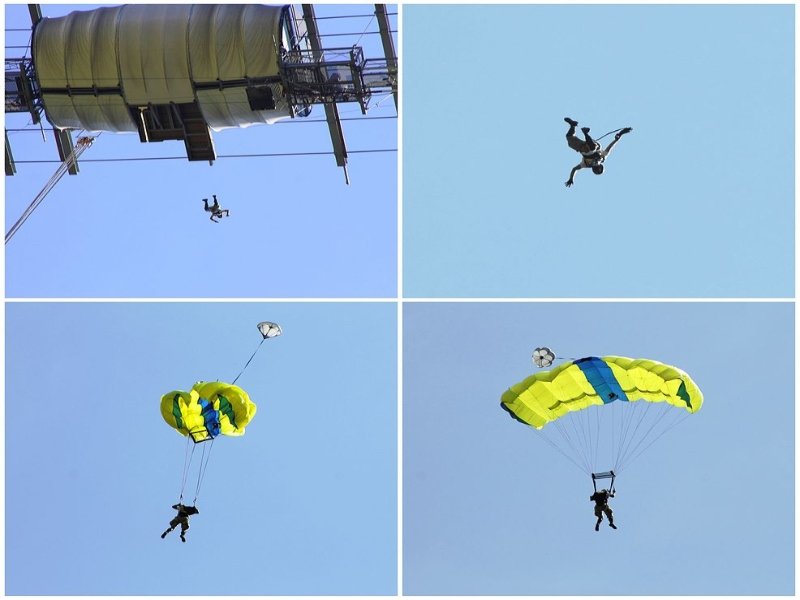
Head injuries are one of the most common and fatal injuries in base jumping. A helmet is a crucial piece of safety equipment that saves a lot of lives in the sport. While some base jumpers are happy to use skydiving helmets, a specific base jumping helmet is best. Base jumping helmets can be a bit more expensive, but they offer more protection against heavy impacts. Get the correct fit, as an ill-fitting helmet can be extremely distracting and dangerous.
Body Armor
Body armor is also vital for base jumping safety. Jumping close to objects means many parts of our body are vulnerable and need solid protection, such as your back, chest, stomach, knees, ankles, and elbows. It’s essential not to opt for the strongest, hard-shell body armor you can find. It would help if you gave a lot of consideration to the fit and comfort. Body armor needs to fit well with the rest of your setup and shouldn’t add too much additional weight or cause you to lose flexibility. You should also consider the climate where you will be base jumping, as excess heat can lead to discomfort and distraction.
Gear Bag
Often overlooked, a gear bag is significant for base jumping. Unlike skydiving, base jumpers tend to negotiate rough and rugged terrain to reach jump spots, so it’s important to have a durable and robust gear bag to keep all your equipment safe and organized. A good gear bag should also be lightweight and big enough to carry everything without adding additional stress or unnecessary weight. We recommend getting a gear bag with hip straps, which helps distribute your load’s weight more comfortably.
Cameras
Perhaps not an essential piece of equipment, but no true base jumper should go without a camera. Every base jump is a big deal, from your first, safe jump, to those more daring and experimental jumps you’ll experience at a professional level; it’s almost a crime not to record and preserve these moments. When purchasing a helmet or body-mounted camera, it’s essential to get something with excellent image stabilization. It’s also important to pick one that attaches to you discreetly and doesn’t cause any distraction or interference with your movement. As well as capturing the moment, having footage of every base jump is also a great way to review and improve your techniques.

